Earthquakes are one of the most powerful natural phenomena that have fascinated scientists and frightened people for centuries. The consequences of underground shocks can lead to massive destruction and human casualties.

The island of Bali is located in a seismically active region known as the 'Ring of Fire,' on the boundary of the Indo-Australian Plate and the Eurasian Plate. These plates are constantly moving, and when they interact, it can result in seismic activity, including earthquakes and volcanic eruptions.

Annually, Bali experiences about 99 earthquakes per year (approximately 8 per month) with a magnitude of 3-4. It's worth noting that earthquakes of magnitude 7 and above are relatively rare in the vicinity of Bali.
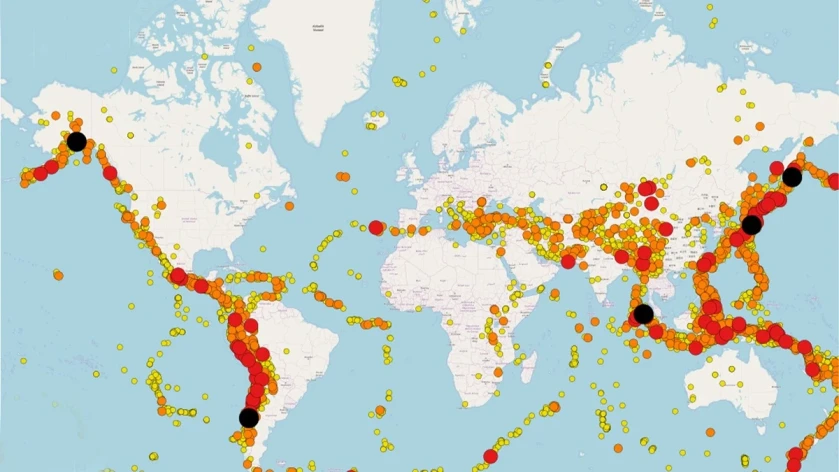
Earthquake on August 29, 2023
However, a strong earthquake with a magnitude of 7.4 occurred deep in the ocean north of the islands of Bali and Lombok, off the coast of South Kalimantan, early on August 29, 2023.
The epicenter was 203 km from Bali at a depth of 10 km below the Earth's surface. The intensity at the epicenter was 7.4, reaching about 4 in Bali. Fortunately, there were no casualties.
The epicenter was 203 km from Bali at a depth of 10 km below the Earth's surface. The intensity at the epicenter was 7.4, reaching about 4 in Bali. Fortunately, there were no casualties.
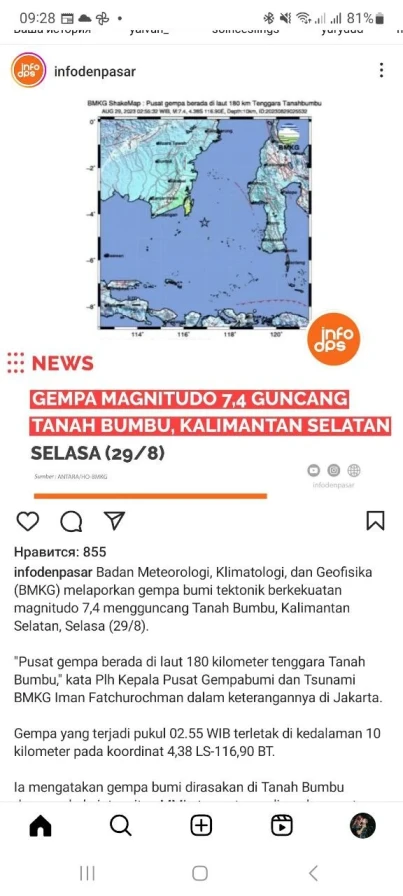
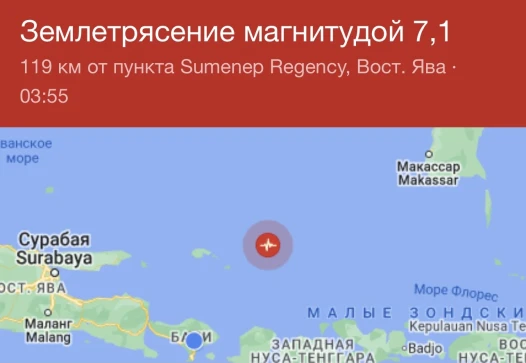
According to reports, the quake was felt uniformly across the island, from the coast to the center. Many people rushed out onto the streets, gathering children and essential documents. Panic and anxiety prevailed. The earthquake lasted for seven minutes, followed by prolonged ground vibrations.
Here's what some users wrote in chats:
"My knees were shaking when we ran out. But it was more a combination of a sudden rise and fear. I only felt the first two, and the rest - not anymore. On the positive side, I saw 'cells' of waves in the pool for the first time - it's very beautiful!"
"Yes, I had only felt 5 points on my feet before this. And now I was almost knocked off my feet."
"I thought the hotel walls would collapse."
"It was shaking a lot here, the whole house was swaying, woke up all the dogs in the neighborhood and me."
Many residents and tourists rushed out of their homes and hotels to higher ground, but the situation returned to normal after they received text messages confirming that the earthquake could not trigger a tsunami.
A tsunami can precede an earthquake with a magnitude of 6 or higher. Before the tidal wave arrives, the water level quickly drops, exposing the shore. This happens within 5-10 minutes. About 20 minutes later, the first strong wave should be expected. The water roars so loudly that the sound can be heard far around.
Usually, the population is alerted. However, if we remember 2004, the tsunami reached the shore 15 minutes after the shocks, making it an unexpected disaster for Bali residents.
Animals are very sensitive to the approach of a deadly wave – they leave the dangerous area or behave very restlessly. If you observe the shore, you can recognize the approach of a tsunami 15 minutes before the catastrophe. The water recedes very strongly, and the sound of the surf is not heard. Thunder-like sounds from the ocean also foreshadow the disaster.
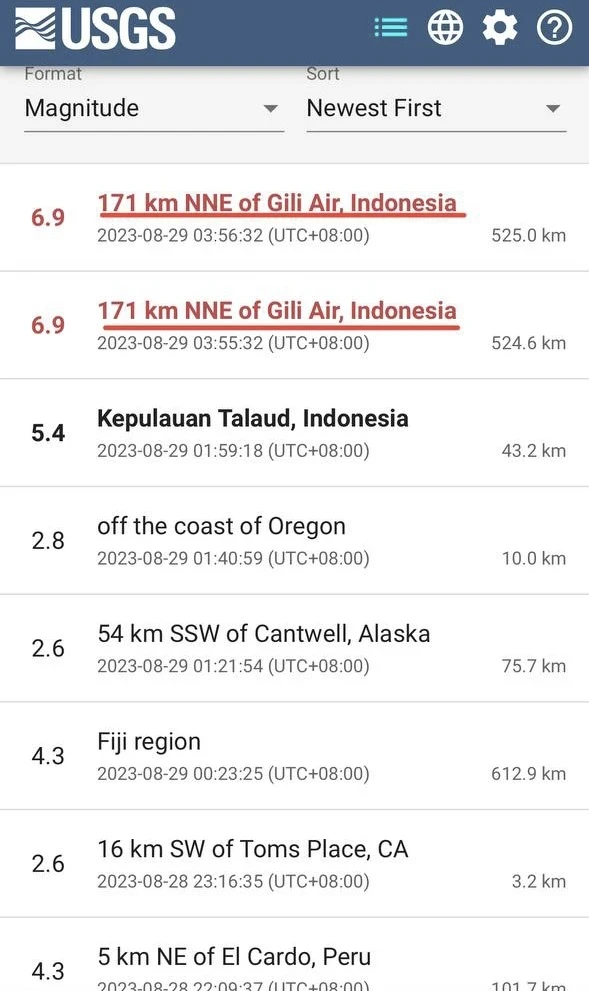
Earthquake Safety Guide
Quickly exit the building, taking documents, money, and essential items with you. When leaving, use the stairs, not the elevator. Once outside, move to an open space and avoid standing near buildings.
If you remain indoors:
- Stand in a safe place: near an inner wall, in a corner, in an inner doorway, or under a sturdy table if possible. This will protect you from falling objects and debris. Stay away from windows and heavy furniture. If you have children with you, shield them.
- Avoid using candles, matches, or lighters, as there could be a gas leak leading to a fire.
- Stay away from overhanging balconies, cornices, parapets, and be wary of hanging wires.
If you are in a vehicle:
- Stay in an open area but do not leave the vehicle until the shaking stops. Be prepared to assist in rescuing others.
- Do not approach obviously damaged buildings and refrain from entering them. Be prepared for strong aftershocks, as the first 2-3 hours after an earthquake are the most dangerous. Avoid entering buildings unless absolutely necessary.
Volcanoes in Bali. Is there a danger?
In Bali, the most well-known active volcano is Mount Agung. It is the highest point on the island, reaching an elevation of 3,031 meters (9,944 feet) above sea level. In recent years, Mount Agung has experienced periods of increased volcanic activity.
Mount Agung has erupted five times. The most recent activity began in late November 2017, leading to the evacuation of thousands of people, suspension of air travel, and environmental damage. As of November 27, 2017, the threat level was at its highest, and evacuation measures were implemented.
Since then, the volcano has been closely monitored, with the Indonesian Center for Volcanology and Geological Hazard Mitigation (PVMBG) paying careful attention to its activity. Various instruments, including seismometers, GPS devices, and gas detectors, are used to track changes in volcanic behavior.
It's important to note that Mount Agung does not have regular eruption intervals. The time between eruptions can vary significantly, and periods of volcanic activity can alternate with periods of relative calm.
For local residents, Mount Agung is considered a sacred mountain and is home to the temple complex of one of Bali's most important Hindu temples - Pura Besakih.

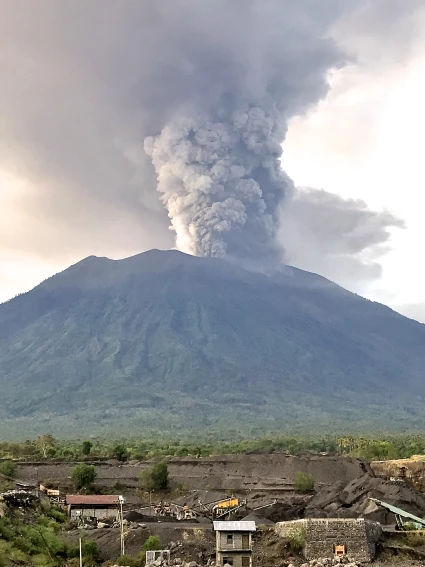
Chronicle of Destructive Earthquakes in Bali
- The most devastating earthquake in Bali occurred in November 1855, reaching a magnitude of 7 on the Richter scale. It is estimated to have claimed the lives of 10,000 people, with the majority of casualties caused by tsunamis.
- In January 1917, underground tremors occurred in mountainous areas. Official records state that landslides and mudflows resulted in the deaths of 1,500 people, and more than 2,000 temples were affected.
- Then, a strong earthquake in July 1976 with a magnitude of 6.5 caused damage to infrastructure and human casualties. The quake claimed the lives of 573 people, and over 90% of buildings in Buleleng were destroyed, leaving around 500,000 locals homeless.
- December 1979. In Karangasem, 27 island residents died, 200 were injured, and 90% of structures were demolished.
- January 2004. Thirty people were affected, with one casualty. Thousands of structures across the island were destroyed. This earthquake triggered a tsunami in the Indian Ocean, caused by a seabed rupture near the island of Sumatra. The rock displacement at a depth of 1.2 kilometers triggered a powerful earthquake (later determined to be of magnitude 9.1). The movement of tectonic plates caused some parts of the seafloor to rise by 20 meters, creating a new 10-meter fault. The shift in lithospheric plates resulted in an enormous energy release, equivalent to 550 million atomic bombs.
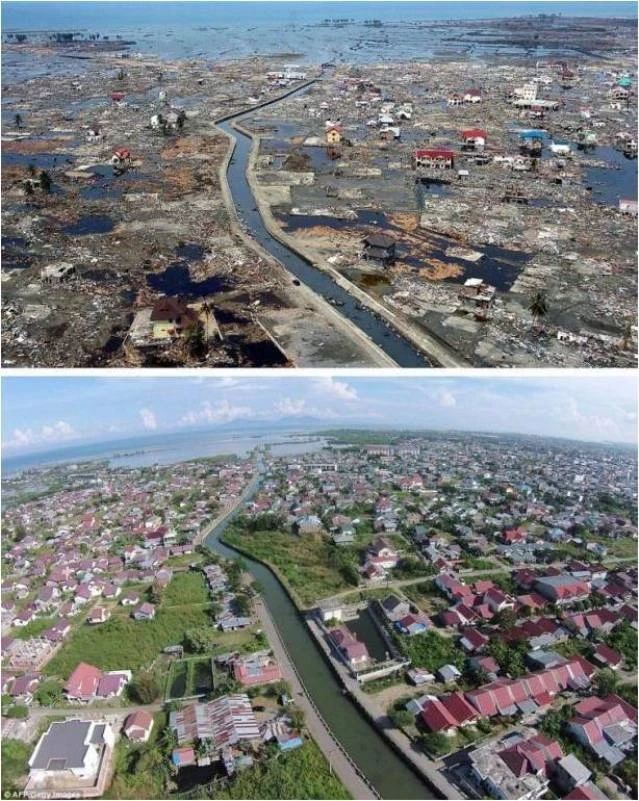
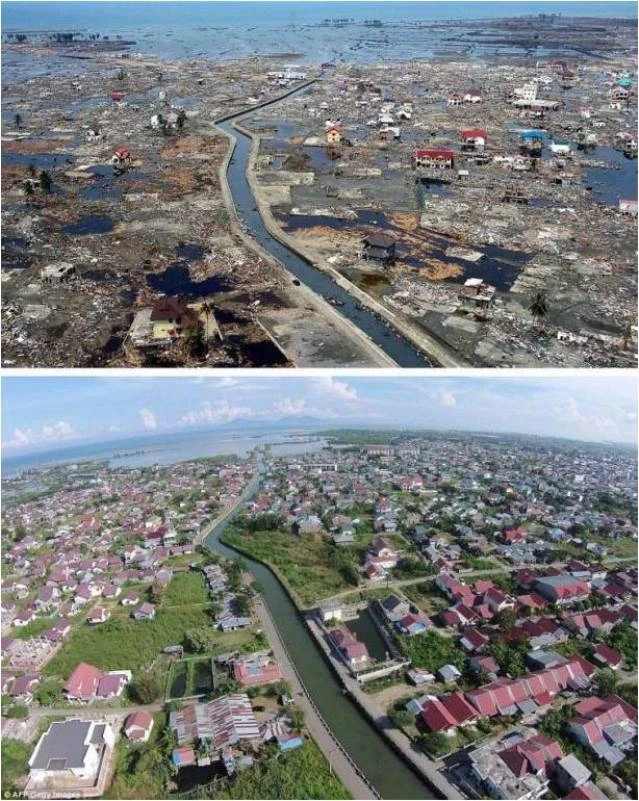
- In August 2018, several earthquakes occurred, affecting the Karangasem region and the east coast of Amed. The neighboring Lombok Island was most severely impacted, along with the northern, eastern, and central areas of Bali. The magnitude 7.0 earthquake resulted in destruction and human casualties. Over 450 people lost their lives.
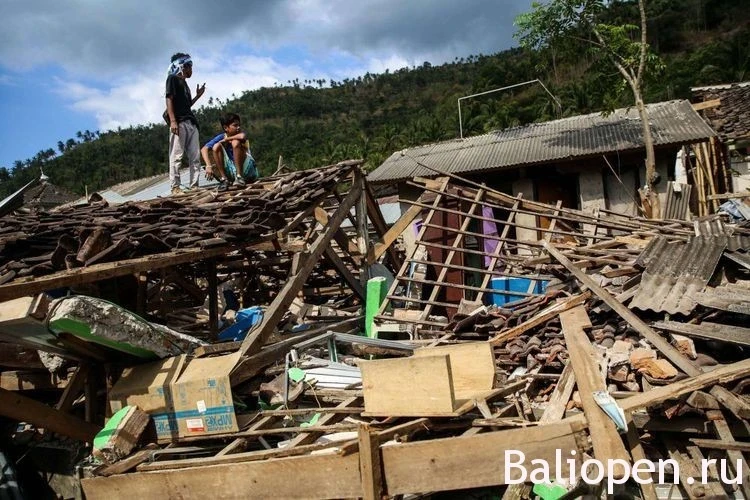
- On October 16, 2022, an earthquake with a magnitude of 4.8 occurred 62 km northeast of Singaraja, the port city of Bali. Reports indicate seven individuals injured with serious wounds. According to the meteorological agency in Jakarta, the tremor was recorded at a depth of 10 kilometers.
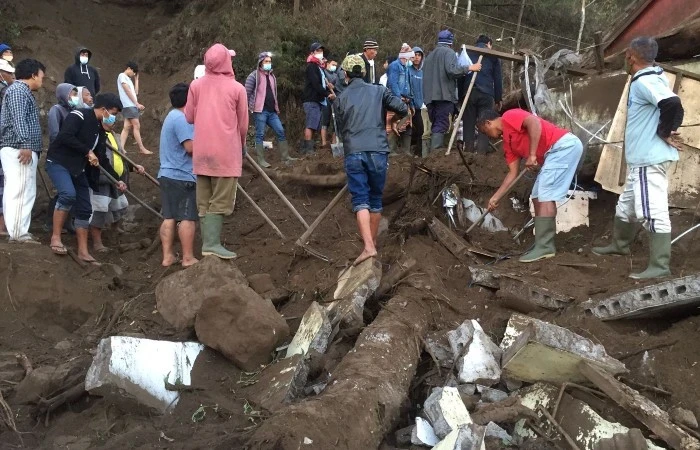
If we trace the dynamics of victims of natural disasters, we can conclude that with each subsequent earthquake, their number decreases. The mountainous regions of the island have been and remain the most dangerous zone.
There are two main types of earthquakes that can occur in the Indonesia region
1. Subduction zone earthquakes: These occur when one tectonic plate is forced beneath another. As the plates rub against each other, stress accumulates and is eventually released.
2. Strike-slip earthquakes: These occur when tectonic plates slide past each other horizontally, causing stress to build up along fault lines.
Theory of elastic rebound: This theory explains how energy accumulates in mountainous rocks in the form of stress, which is released when the rock breaks, causing an earthquake.
Key factors influencing earthquakes in Bali
- - Tectonic forces: The Earth's crust is divided into large and small pieces known as tectonic plates. When plates collide, pull apart, or slide past each other, the accumulation of stress can lead to an earthquake.
- - Faults: These are cracks or zones of fracture between two blocks of rock. They represent areas where the load on the rock has exceeded its internal strength, leading to displacement. The magnitude of an earthquake largely depends on the degree of fault displacement and the surface area of the fault that moves.
- - Depth of focus: The point inside the Earth where an earthquake begins is called the focus. Generally, earthquakes with a shallow focus cause more damage than those with a deep focus.
- - Properties of mountainous rocks: Including their type, temperature, and pressure conditions. These factors can influence how much stress they can accumulate before breaking and causing an earthquake. Some rocks are more brittle and prone to rupture, while others can deform more before breaking.
- - Geological structures: Certain geological structures, such as subduction zones, where one tectonic plate is forced beneath another, are more prone to earthquakes. These zones are often associated with the most powerful and destructive earthquakes.
Frequency of earthquakes in Bali
To track earthquakes and their frequency and obtain information on seismic activity, we recommend the website earthquaketrack.com. It provides information on past and real-time earthquakes in Bali.


Can earthquakes be prevented?
"Currently, it is impossible to accurately predict when and where an earthquake may occur. However, scientists now believe that Global Positioning System (GPS) data can help detect early warning signs two hours before strong earthquakes occur by tracking slight movements of tectonic plates as they rub against each other," writes a new study published on July 20 in the journal Geophysics.
All that can be done is to assess seismic resistance.
Seismic risk assessments are primarily based on:
1. Studying the seismic history of the area (number, type, and impact of earthquakes in prehistoric and historic times, as well as currently).
2. Identifying and detailed analysis of risky territories and objects.
3. Studying the quality and quantity of buildings and other vulnerable elements.
4. Reinforcing existing structures and creating new ones, including homes, infrastructure, life support systems, etc.
5. Conducting monitoring and seismological research.
Is Bali dangerous?
According to local legislation, when constructing buildings in Bali, the structure must be designed to withstand an 8.5 magnitude earthquake.
Earthquakes are a global phenomenon, constantly occurring worldwide. Numerous volcanoes serve as another reminder of potential risks.
It is essential to understand the potential danger of earthquakes in Bali. The unsettling experience of suddenly waking up at night when the ground shakes beneath you, and the walls of the house and the water in the pool ripple, is a crucial reminder of the unpredictability of natural forces in the place where we live or vacation.
While historical chronology may not necessarily indicate significant seismic events, underground tremors certainly cause concern for many people. The island is not immune to such occurrences.
Yes, humans have learned to disperse and condense clouds in the sky, but preventing what remains beyond human capabilities is not within reach.
If the question of coming remains open for you, someone may find solace in the absence of significant past catastrophes, while others may feel uncomfortable at the thought of living on such unstable ground.
You can add one right now!